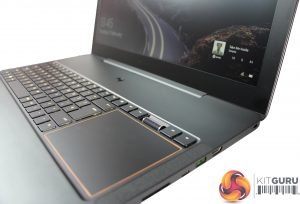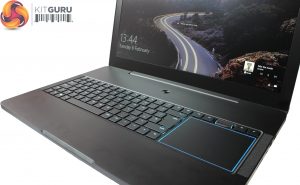The Razer’s keyboard and trackpad arrangement is initially disarming. We spent a good amount of time dragging our fingers down to where the trackpad is usually found, beneath the keyboard, and the arrangement means the keyboard shifts a little to the left – so we initially missed quite a few keystrokes, too.
Once you’ve acclimatised, there’s a lot to like about the Blade Pro’s revised design. The trackpad’s right-hand position mirrors how right-handed people use a computer, and the keyboard’s buttons are still full-size, with a double-height Return key and dedicated media buttons.
The keyboard itself is a typical chiclet unit, with keys that are consistent and comfortable. They’re reasonably quiet, and their satisfying action is paired with individual RGB LEDs that can be customised in software.
The keyboard is fast and consistent, but it suffers from the usual chiclet problems – the same issues that afflicted the PC Specialist and the Asus Scar. While the keys have attributes that are superb in the office and when fast typing is required, the relative lack of travel and the softer, quieter typing action mean that the keyboard does fall short in particularly frantic games.
That’s not a problem unique to the Blade Pro – almost every gaming laptop on the market suffers similarly. And, pleasingly, the trackpad is excellent, with a large, smooth surface and in-built buttons that are fast and shallow enough for most games. Only the keenest of competitive gamers will want to connect a USB mouse.
There’s also plenty to like about the Razer’s screen. Its Full HD resolution is paired with an IPS panel underneath, and it has a matte finish plus a 120Hz refresh rate. Those are all good attributes, but we are a little disappointed that there’s no sign of Nvidia G-Sync. It’s a little unusual for a prestige portable like this, and it means that games will not be as smooth as they could have been with GPU frames and screen refresh rates synchronised.
It’s a similar situation to the Asus Scar and PC Specialist machines, which both have 120Hz refresh rates but no synchronising technology. On these machines you’ll get smooth gaming if you use V-Sync and have games running at nearer to 120fps, but you’ll still experience a little tearing.
Still, the screen has a good specification, and it’s bolstered by solid benchmark results. The Razer’s brightness level of 372cd/m2 is huge, and almost 100cd/m2 higher than the PC Specialist – so there’s enough backlight power to handle bright lights and even the great outdoors.
The excellent brightness level is joined by a good black point of 0.24cd/m2, which is almost as solid as the PC Specialist’s figure. That means that dark areas in games will be suitably deep, which bodes well for moody games and films.
The contrast ratio of 1,550:1 is stonking and helps create plenty of vibrancy and detail across the entire sRGB spectrum.
The Blade Pro returned more ordinary scores in colour tests. While its colour temperature figure of 6,763K is reasonable, the Delta E of 4.7 and Gamma of 2.12 are average. The screen also only rendered 86.2% of the sRGB colour gamut.
Those aren’t disastrous results, though, and they only mean that the Blade Pro won’t handle the most colour-sensitive tasks. For the vast majority of work applications, and for games, it’s easily good enough.
The good screen is joined by solid speakers. The Blade Pro produces reasonable bass despite its lack of subwoofer, and there’s a clear mid-range and a well-defined high-end that is never too tinny or distorted. A headset will be better, of course, but this audio gear is definitely good enough for games and movies.
 KitGuru KitGuru.net – Tech News | Hardware News | Hardware Reviews | IOS | Mobile | Gaming | Graphics Cards
KitGuru KitGuru.net – Tech News | Hardware News | Hardware Reviews | IOS | Mobile | Gaming | Graphics Cards




